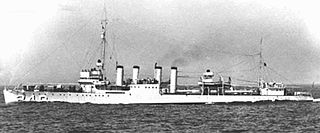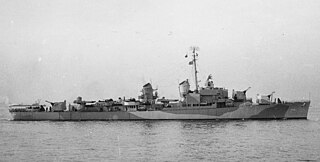
USS Cole (DD-155) was a Wickes-class destroyer in the United States Navy during World War II, later reclassified as AG-116. It was named for Edward B. Cole, a United States Marine Corps officer who died as a result of the wounds he received at the Battle of Belleau Wood.

USS Jacob Jones (DD-130), named for Commodore Jacob Jones USN (1768–1850), was a Wickes-class destroyer. She was sunk by a German submarine in 1942 during World War II.

USS Schenck (DD-159) was a Wickes-class destroyer in the United States Navy during World War II. She was named for Rear Admiral James F. Schenck, USN (1807–1882).

USS McDougal was an O'Brien-class destroyer built for the United States Navy prior to the American entry into World War I. The ship was the second U.S. Navy vessel named in honor of David Stockton McDougal, a U.S. Navy officer notable for his leadership during an 1863 battle off Japan while in command of Wyoming.

USS Kanawha (AO–1) was the lead ship of her class of replenishment oilers of the United States Navy. She was commissioned in 1915 and sunk on 8 April 1943 by Japanese aircraft off Tulagi, Solomon Islands.

USS John D. Edwards (DD-216) was a Clemson-class destroyer in the United States Navy during World War II.

USS MacLeish (DD-220/AG-87) was a Clemson-class destroyer in the United States Navy during World War II. She was named for Lieutenant Kenneth MacLeish.

USS Truxtun (DD-229) was a Clemson-class destroyer in the United States Navy during World War II. She was the third ship named for Thomas Truxtun.

USS Sturtevant (DD-240) was a Clemson-class destroyer in the United States Navy during World War II. She was the first ship named for Albert D. Sturtevant.

USS Goff (DD-247) was a Clemson-class destroyer in the United States Navy during World War II. She was named for Secretary of the Navy Nathan Goff, Jr.

USS Macomb (DD-458/DMS-23) was a Gleaves-class destroyer of the United States Navy, named for Commodore William H. Macomb (1819–1872) and Rear Admiral David B. Macomb (1827–1911).

USS Sicard (DD-346/DM-21/AG-100) was a Clemson-class destroyer in the United States Navy following World War I. She was named for Montgomery Sicard.

USS John R. Pierce (DD-753), an Allen M. Sumner-class destroyer, is the only ship of the United States Navy to be named for Lieutenant Commander John Reeves Pierce.

USS James C. Owens (DD-776), an Allen M. Sumner-class destroyer, is the only ship of the United States Navy FRAM II class to be named for Lieutenant James C. Owens Jr., a member of Torpedo Squadron 8 on board USS Hornet. His entire squadron was lost in an attack against Japanese aircraft carriers 4 June during the Battle of Midway. Lt. Owens received the Navy Cross and the Presidential Unit Citation (US) posthumously.

The second USS Mayrant (DD-402) was a Benham-class destroyer in the United States Navy, the second ship named for John Mayrant. Commissioned shortly before World War II, she was primarily active in the Atlantic theater of the war, and was decommissioned after being used as a target in the Operation Crossroads atomic weapons tests.

USS Warrington (DD-383) was a Somers-class destroyer, laid down on 10 October 1935 at Kearny, New Jersey, by the Federal Shipbuilding and Drydock Company; launched on 15 May 1937; sponsored by Miss Katherine Taft Chubb; and commissioned at the New York Navy Yard on 9 February 1938.

USS Hissem (DE-400/DER-400) was an Edsall class destroyer escort of the United States Navy. Hissem was constructed in 1943 as DE-400. In 1955, the vessel was equipped with modern radars, and the designation was changed to DER-400. The special purpose of DER ships was the detection of aircraft. Their chief role was to extend the DEW line out into the N. Atlantic and the N. Pacific oceans.

USS Rhind (DD-404) was a Benham-class destroyer in the United States Navy. She was named for Alexander Colden Rhind.

USS John Willis (DE-1027) was a Dealey-class destroyer escort in the United States Navy in service from 1957 to 1972.

USS Maurice J. Manuel (DE-351) was a John C. Butler-class destroyer escort acquired by the U.S. Navy during World War II. The primary purpose of the destroyer escort was to escort and protect ships in convoy, in addition to other tasks as assigned, such as patrol or radar picket.





















